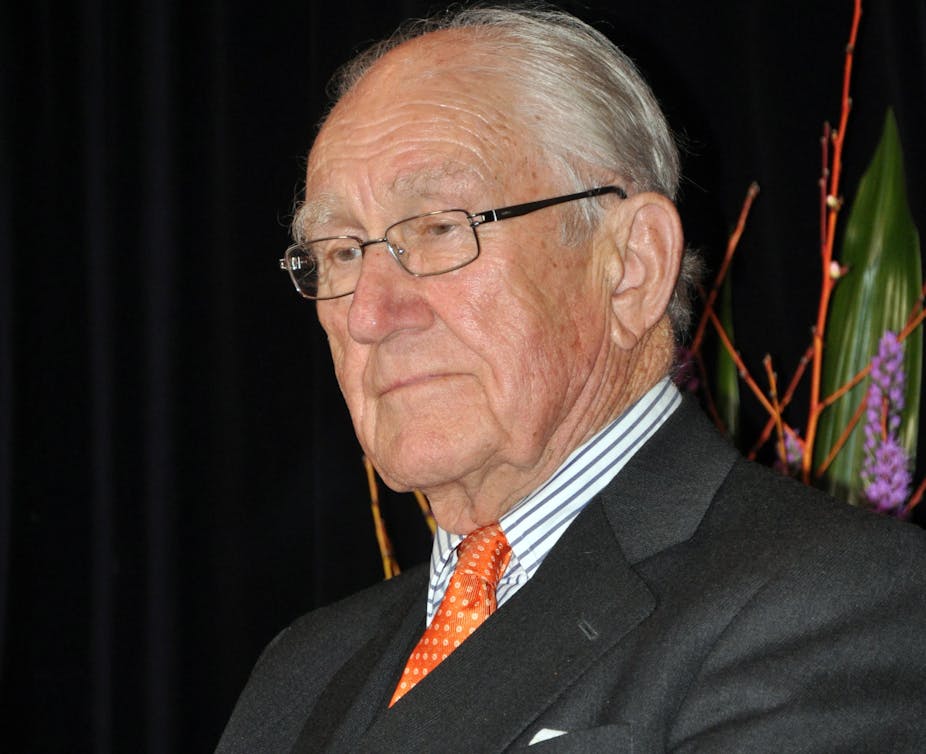It was the greatest political transformation of any major Australian public figure in modern times. Malcolm Fraser, “the crazy grazier” who in 1975 did whatever it took to “rescue” the nation from its first federal Labor government in almost a quarter of a century, moved progressively away from the party for whom he had once been a conquering hero.
The drift from the Liberal Party began as soon as Fraser exited the parliament in the wake of his government’s 1983 election defeat. And as the years rolled by, it picked up pace.
Having been granted life membership of the party in 2000, the honour came to mean little, if anything, to him. Following Tony Abbott’s ascension to the leadership in December 2009, Fraser terminated that membership because he believed the party to which he had devoted his best years had lost its right to call itself “liberal” and had become “a party of fear”.
Fraser’s ideological shift continued even after that, as he moved into his 80s. By 2014, in his book Dangerous Allies, he argued for Australia to end its alliance with the United States – an alliance that is a fundamental and unshakable tenet of his old party’s comprehension of the nation’s place in the world. It had once also been a bedrock element of his own approach to world affairs.
By then, Fraser’s estrangement from the Liberals had itself become a fundamental feature of public debate. The rift had deepened with his long-running criticisms of the party’s approach to asylum seekers, multiculturalism, Asian immigration and a range of defence and foreign policy issues, especially its willingness to participate in the 2003 invasion of Iraq.
From party leader to exile
The transition from hate figure for the Labor Party and its supporters to advocate for many policies that are to the left of the contemporary ALP will long be a subject for examination and discussion. Fraser argued that he hadn’t changed; it was the Liberal Party that had changed. A more credible assessment is that both had changed.
Fraser was a unique combination as a politician. He possessed a fierce will to power. To satisfy that, he devoted himself to mastering the nation’s formal political structures.
Essentially, in 1975 Fraser took over the Liberal Party on his second attempt to unseat Billy Snedden as leader and then forced the Queen’s representative, Sir John Kerr, to bend the Constitution to conform to his ambition. In order to attain the power that he regarded as his party’s natural right over an unworthy and illegitimate Labor administration, he was willing to put at risk Australia’s social order.
Yet, throughout his prime ministership and his lifetime, Fraser’s chief public policy concerns were personal, ethical and social. The “hard” policy areas of financial, industrial, trade and labour relations reform – what might be regarded as the biggest pieces of machinery of government and the economy – did not animate him in the way that multiculturalism, migration, refugee resettlement, the environment and Indigenous affairs did.
Fraser was, despite the lengths he had gone to challenge political conventions on his path to power, so determined to appear to run a government that was above board that he was willing to ditch ministers and MPs at the faintest whiff of bad behaviour, often at his own political cost. This was of a piece with his great passion of trying to fight racism wherever he saw it – most notably and controversially in South Africa.
Over the years, Fraser and the Liberal Party grew less tolerant of each other. What made Fraser’s falling-out with the party he had led to three successive election victories so remarkable was that it was so unusual. Labor’s history is studded, right from its earliest days, with what its adherents refer to as “rats”: Joseph Cook, Chris Watson, Billy Hughes and a large segment of his cabinet, Joe Lyons.
But the return traffic has been thin.
Fraser could never be said to have thrown in his lot with the ALP, of course. Often, his specific policy criticisms were equally applicable to the Labor Party. But they carried extra weight in terms of providing a critique of the non-Labor side because of his storied career as a Liberal world-beater.
Legacy poses a dilemma for Liberals
Just how the next generation of Liberals come to regard Fraser – as a flawed, fallen hero or faithful, principled critic – will be fascinating to see.
What can’t be ruled out as an explanation for Fraser’s unique political journey is his own personality. The first thing that struck me when I was sent to Canberra to cover his government for the now-defunct Melbourne Herald in 1979 was how alone Fraser the prime minister was.
In every encounter I witnessed, he seemed … removed. This was often taken for aloofness but it looked to have deeper roots, a reflection of personality rather than attitude.
Fraser’s early childhood appears to have been a carefree, Huck Finn-style, if quite isolated, life on his family’s farm in the Riverina. But it introduced a sadness to him that was still evident in him in his advanced years.
In his 2010 autobiography, Malcolm Fraser: The Political Memoirs, co-authored with Margaret Simons, he recalls how he was sent away, aged 10, from his idyllic, self-absorbed life to board at Tudor House in the southern highlands of New South Wales. For the first time, he was surrounded by boys his own age, but by his own admission it was:
… too late. The die was cast. I had been solitary for too long so I was still in part self-contained or reserved or whatever. I don’t think anything really was going to alter that.
Nothing did. Left to his own devices after he veered from the parliamentary track, that lonely, unreachable, idealistic boy took off yet again to tread his own path.

